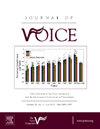职业性嗓音障碍是否得到准确测量?对学校教师报告嗓音障碍的流行率和方法的系统回顾。
IF 2.5
4区 医学
Q1 AUDIOLOGY & SPEECH-LANGUAGE PATHOLOGY
引用次数: 0
摘要
目的:为确定嗓音疾病在学校教师中的流行情况,人们使用了不同的测量工具。然而,由于患病率的差异,很难确定嗓音疾病对这一群体的影响。本调查旨在回顾和确定对教师嗓音疾病进行方法学分析的科学证据、测量工具的相关性、发音障碍的患病率以及对制定嗓音健康预防计划的影响:方法:通过搜索六个重要的科学数据库进行了系统回顾。方法:通过搜索六个重要的科学数据库进行了系统性综述,并执行了系统性综述首选报告项目(PRISMA)指南。结果:在 8,998 篇文章中,有 20 篇被收录:从 8,998 篇文章中筛选出 20 篇。在所有调查中,横断面设计类型占主导地位。不同研究的参与人数存在差异,导致患病率数据也不尽相同--从 10.5% 到 69.1%不等。评估工具的使用不规范,无法有效确定疾病负担。尽管有大量证据表明解决教师发音障碍问题的方案是有效的,但关于由政府或教育机构推广的系统方案的文献却非常少:研究结果表明,未来的调查应考虑就教师职业性发音障碍的全球定义达成共识,以便开发精确的测量工具,并协助该人群的嗓音保健计划和治疗方法。这一点可能至关重要,因为它还有助于实施德尔菲式研究,从而支持围绕学校教师的这些计划(嗓音保健和治疗方法)达成进一步的循证协议。本文章由计算机程序翻译,如有差异,请以英文原文为准。
Are Occupational Voice Disorders Accurately Measured? A Systematic Review of Prevalence and Methodologies in Schoolteachers to Report Voice Disorders
Purpose
Different measuring instruments have been described to determine the prevalence of voice disorders in schoolteachers. However, the heterogeneity of prevalence figures has made it difficult in determining the impact of voice disorders in this group. This investigation aims to review and identify scientific evidence of methodological analysis of voice disorders in teachers, the relevance of measuring instruments, the prevalence of dysphonia, and the impact on the development of vocal health prevention programs.
Methods
A systematic review was conducted by searching six important scientific databases. Preferred Reporting Items for Systematic Reviews (PRISMA) guidelines were carried out. Articles were included whether they presented data related to the prevalence of dysphonia and the impact of therapy programs on teachers.
Results
Twenty articles out of 8,998 were selected. The cross-sectional design type was predominant throughout the investigations. Differences were observed in the number of participants across studies, leading to heterogeneous prevalence figures – which ranged from 10.5% to 69.1%. The assessment instruments are not standardly used to effectively determine the disease burden. Despite the fact of the extensive evidence of the effectiveness of programs that address dysphonia in teachers, the scarcity of literature is yet evident on systematic programs promoted by either the government or educational institutions.
Conclusion
Findings suggest that future investigations should consider the consensus of a global definition for occupational dysphonia in teachers in order to develop accurately measuring instruments and to assist with voice care programs and treatment approaches in this population. This might be crucial since it could also assist with the implementation of Delphi-type studies that could support the development of further evidence-based agreements around these programs (voice care and treatment approaches) in schoolteachers.
求助全文
通过发布文献求助,成功后即可免费获取论文全文。
去求助
来源期刊

Journal of Voice
医学-耳鼻喉科学
CiteScore
4.00
自引率
13.60%
发文量
395
审稿时长
59 days
期刊介绍:
The Journal of Voice is widely regarded as the world''s premiere journal for voice medicine and research. This peer-reviewed publication is listed in Index Medicus and is indexed by the Institute for Scientific Information. The journal contains articles written by experts throughout the world on all topics in voice sciences, voice medicine and surgery, and speech-language pathologists'' management of voice-related problems. The journal includes clinical articles, clinical research, and laboratory research. Members of the Foundation receive the journal as a benefit of membership.
 求助内容:
求助内容: 应助结果提醒方式:
应助结果提醒方式:


